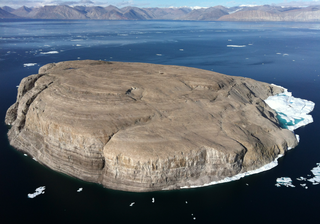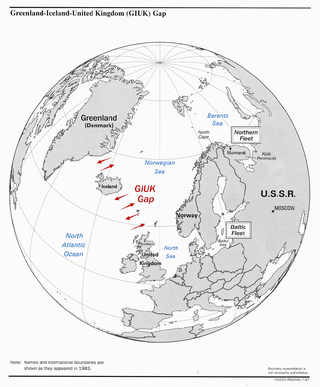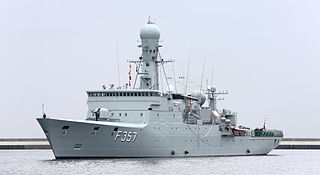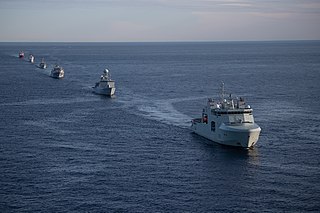Danish Armed Forces is the unified armed forces of the Kingdom of Denmark charged with the defence of Denmark and its self-governing territories Greenland and the Faroe Islands. The military also promote Denmark's wider interests, support international peacekeeping efforts and provide humanitarian aid.

Greenland is an autonomous territory in the Kingdom of Denmark. It is the largest of three constituent parts of the kingdom, the other two being metropolitan Denmark and the Faroe Islands; the citizens of all territories are full citizens of Denmark. Greenland is one of the Overseas Countries and Territories of the European Union. The capital and largest city of Greenland is Nuuk. Greenland lies between the Arctic and Atlantic oceans, east of the Canadian Arctic Archipelago. It is the world's largest island, and is the location of the northernmost point of land in the world—Kaffeklubben Island off the northern coast is the world's northernmost undisputed point of land; Cape Morris Jesup on the mainland was thought to be so until the 1960s. Economically, Greenland is heavily reliant on aid from Denmark, amounting to near half of the territory's total public revenue.

The Royal Danish Navy is the sea-based branch of the Danish Armed Forces force. The RDN is mainly responsible for maritime defence and maintaining the sovereignty of Danish territorial waters. Other tasks include surveillance, search and rescue, icebreaking, oil spill recovery and prevention as well as contributions to international tasks and forces.

Kangerlussuaq is a settlement in western Greenland in the Qeqqata municipality located at the head of the fjord of the same name. It was Greenland's main air transport hub and the site of Greenland's largest commercial airport until the new airport opened at Nuuk on 28 November 2024. The airport dates from American settlement during and after World War II, when the site was known as Bluie West-8 and then Sondrestrom Air Base.

Hans Island is an island in the centre of the Kennedy Channel of Nares Strait in the high Arctic region, split between the Canadian territory of Nunavut and the Danish autonomous territory of Greenland. The island itself is barren and uninhabited with an area of 130 hectares, measuring 1,290 by 1,199 metres, and a maximum elevation of 168.17 m (551.7 ft). Its location in the strait that separates Ellesmere Island of Canada from northern Greenland was for years a border dispute, the so-called Whisky War between the two countries of Canada and Denmark. Hans Island is the smallest of three islands in Kennedy Channel off the Washington Land coast; the others are Franklin Island and Crozier Island. The strait at this point is 35 km (22 mi) wide, placing the island within the territorial waters of both Canada and Denmark (Greenland). A 1,280-metre-long (4,200 ft) shared border traverses the island.

The GIUK gap is an area in the northern Atlantic Ocean that forms a naval choke point. Its name is an acronym for Greenland, Iceland, and the United Kingdom, the gap being the two stretches of open ocean among these three landmasses. It separates the Norwegian Sea and the North Sea from the open Atlantic Ocean. The term is typically used in relation to military topics. The area has for some nations been considered strategically important since the beginning of the 20th century.

Island Command Greenland, or simply "GLK", was a Level.II authority responsible directly to the Defence Command. It was, among other things, responsible for the military defense of Greenland, maritime and sovereignty maintenance and enforcement, as well as search and rescue. Personnel assigned to the Danish liaison office at Thule Air Base (FOTAB) as well as the Sirius Patrol were also a part of the Greenland Command. Island Command Greenland was amalgamated with Island Command Faroes to a Joint Arctic Command on 31 October 2012.

The Norwegian Coast Guard is a maritime military force which is part of the Royal Norwegian Navy. The coast guard's responsibility are for fisheries inspection, customs enforcement, border control, law enforcement, shipping inspection, environmental protection, and search and rescue. It operates throughout Norway's 2,385,178-square-kilometer (920,922 sq mi) exclusive economic zone (EEZ), internal waters and territorial waters. It is headquartered at Sortland Naval Base. In 2023 the Coast Guard had 900 employees, including conscripts, and a budget of 1.3 billion Norwegian krone.

Kangerlussuaq Airport is an airport in Kangerlussuaq, a settlement in the Qeqqata municipality in central-western Greenland. Alongside Nuuk Airport and Narsarsuaq Airport, it is one of only three civilian airports in Greenland large enough to handle large aircraft.

The Thetis-class ocean patrol vessels or ocean patrol frigates, also called Stanflex 3000, is a class of large patrol vessels built for the Royal Danish Navy. The class comprises four ships, all built and commissioned in the early 1990s. The ships' tasks are mainly maintenance of sovereignty, search and rescue, fishery inspection and support to local authorities. The operation areas are normally Greenland and the Faroe Islands, but the vessels also operate near Iceland on transit between Greenland and the Faroe Islands, and near Denmark.

The Danish Realm, officially the Kingdom of Denmark, or simply Denmark, is a sovereign state consisting of a collection of constituent territories united by the Constitutional Act, which applies to the entire territory. It consists of metropolitan Denmark—the kingdom's territory in continental Europe and sometimes called "Denmark proper" —and the realm's two autonomous regions: the Faroe Islands in the North Atlantic and Greenland in North America. The relationship between the three parts of the Kingdom is known as Rigsfællesskabet.

Eskadrille 721 of the Royal Danish Air Force is the sole squadron in 'Air Transport Wing Aalborg' of the Danish Defence. It provides tactical transport for all parts of the Danish state.

Operation Nanook is an annual sovereignty operation and manoeuvre warfare exercise conducted by the Canadian Armed Forces in the Arctic. Sovereignty patrols in the Canadian Arctic Archipelago and northern Canada are conducted by the Canadian Rangers, Canadian Coast Guard in tandem with the Royal Canadian Mounted Police. The exercise portion is intended to train the different elements of the Canadian Armed Forces to operate in the Arctic environment, as well as promote cooperation with allies and close military partners such as the United States Navy and Royal Danish Navy. It can involve multiple components, which are conducted at different times, places and by different units.
Maritime domain awareness (MDA) is defined by the International Maritime Organization as the effective understanding of anything associated with the maritime domain that could impact the security, safety, economy, or environment. MDA is said to work as a ‘key enabler’ for other maritime security issues, such as anti-piracy patrols, in the way that in order to do effective patrols you need to have the ability of conducting effective MDA. The maritime domain is defined as all areas and things of, on, under, relating to, adjacent to, or bordering on a sea, ocean, or other navigable waterway, including all maritime-related activities, infrastructure, people, cargo, and vessels and other conveyances.

The Arctic Policy of the Kingdom of Denmark defines the Kingdom's foreign relations and policies with other Arctic countries, and the Kingdom's strategy for the Arctic on issues occurring within the geographic boundaries of "the Arctic" or related to the Arctic or its peoples. In order to clearly understand the Danish geopolitical importance of the Arctic, it is necessary to mention Denmark's territorial claims in areas beyond its exclusive EEZ in areas around the Faroe Islands and north of Greenland covering parts of the North Pole, which is also claimed by Russia.

The Joint Arctic Command is a direct Level II authority in the Danish Defence. Joint Arctic Command's primary mission in peacetime is to ensure Danish sovereignty by monitoring the area around the Faroe Islands and Greenland. The command also handles tasks such as fisheries inspection, search and rescue (SAR), patient transport and other tasks that support the civil society. In short, the Joint Arctic Command handles military tasks, coast guard duties and disaster response - all in one organisation.
The following is a hierarchical outline for the Danish armed forces at the end of the Cold War. It is intended to convey the connections and relationships between units and formations. In wartime all Danish military units would have come under the joint West German/Danish NATO command Allied Forces Baltic Approaches (BALTAP). BALTAP was a principal subordinate command under the Allied Forces Northern Europe Command (AFNORTH). The commander-in-chief of (BALTAP) was always a Danish Lieutenant General or Vice Admiral, who had the designation Commander Allied Forces Baltic Approaches (COMBALTAP). In peacetime BALTAP had only a few communication units allocated and all other units remained under national command of West Germany's Bundeswehr and Denmark's Forsvaret.

Since the 19th century, the United States has considered, and made, several attempts to purchase the island of Greenland from Denmark, as it did with the Danish West Indies in 1917. Internal discussions within the United States government about acquiring Greenland notably occurred in 1867, 1910, 1946, 1955, 2019 and 2025 and acquisition has been advocated by American secretaries of state William H. Seward and James F. Byrnes, privately by vice president Nelson Rockefeller, and publicly by president Donald Trump, among others. After World War II, the United States secretly offered to buy Greenland; public discussion of purchasing the island occurred during Trump's first term in 2019 and again after Trump's 2024 reelection as part of his Greater United States policy.
Ida Bachmann (1900–1995) was a Danish librarian and journalist who is known for her feminist activities. She was a member of the Commission of the Women's International Democratic Federation (WIDF) and served as its vice president.















